
Hanging by the pool or playing on the beach is a lot more fun when you actually get in the water. And whether you're swimming for fun or sport, making a few simple tweaks to your stroke will seriously boost both your swimming ability and your enjoyment.
Not only will you glide through the water faster and more efficiently, you'll be able to swim farther before getting tired. Read on for tips to polish your freestyle stroke.
Related Reading
1. Wade In

Unless you live seaside, odds are you haven't swum since last summer, so take your time and set realistic expectations. "Being in great shape doesn't always translate to swimming," says Robbin White, co-founder of the Starfish Aquatics Institute.
"I've worked with world-ranked triathletes and marathoners who needed to start slow in the water." White suggests floating on your back or stomach to familiarize yourself with the weightless sensation, wearing flippers to help you glide through the water and wearing a snorkel to allow yourself to focus solely on your strokes.
2. Breathe the Right Way
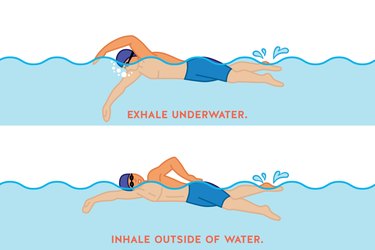
You probably don't give much thought to how you breathe most of the time. But when you're swimming, breathing is a conscious, deliberate act that can mess up your stroke if you do it improperly. The basic rule: Inhale outside of the water, exhale underwater. It's the last part that's hardest (obviously).
In the shallow end of the pool, get used to the feeling of blowing bubbles under the water. "Gently exhale with your nose and mouth, then roll — don't lift — your head to the side and inhale only through your mouth," says Jennifer Harrison, a Chicago-based triathlon coach. "This motion should feel rhythmic and in pace with your strokes."
Practice breathing on both sides. Experiment breathing every two, three or four strokes to see what cadence feels comfortable to you. And never try to inhale and exhale when your face rolls out of the water or you'll get winded quickly.
3. Reach Out Far
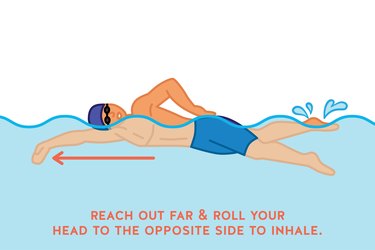
When you extend each arm ahead of you, stretch it as far as you can. Doing so will actually help you breathe better, says Jenn Tyler, owner of Happy Swimmers.
"For example, when you reach far with your right hand, your entire body will naturally twist to the left, making it easier for you to roll your head and inhale." Think about twisting from your hips and torso as you reach.
Related Reading
4. Keep Your Body in Line

"If you lift your head above the waterline, you'll push the water ahead of you and your entire body will start to sink, creating unnecessary resistance," Tyler says. Instead, keep your body as straight as possible with your head in line with your shoulders and hips. Think of "swimming tall" through the water.
Tip
“Have a friend film you swimming across the pool so you know what you look like,” Harrison says. “Unlike the gym, where there are mirrors everywhere, you can’t see yourself swim.”
5. Kick From the Hip
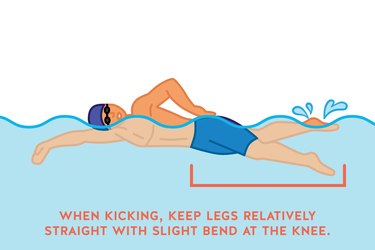
In the freestyle stroke, your legs will be pumping up and down as you move through the water. To do that without getting tired, keep your legs close to each other and kick from the hip. Keep the legs relatively straight, with only a slight bend at the knee. (Don't kick from your knees as if you're kicking a soccer ball.) Lightly squeezing your butt throughout the motion will help you engage the correct muscles to kick from the hips.
6. Point Your Toes
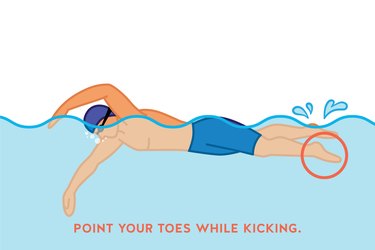
"The best swimmers point their toes while kicking," Harrison says. "If you flex your feet you'll just drag through the water." Pointing your toes is easier when you have strong calves, so practice a variety of calf exercises both at the gym and at home.
Try a simple calf raise: Stand while holding onto a sturdy chair for balance, and slowly raise and lower your body by lifting your heels. Do 3 sets of 10 reps a few times a week.When this starts to feel too easy, progress to single-leg calf raises, lifting on one leg at a time.
7. Push Your Chest Down
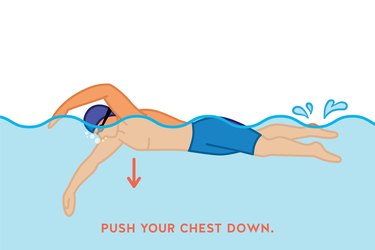
Since the water itself is meant to support your body, "You should always feel like you're swimming downhill," Harrison says. To that end, your head and trunk should be positioned just a little lower in the water than your hips. Play around with how far you push your chest down; there should be a sweet spot where you feel like you're gliding through the water with less resistance.